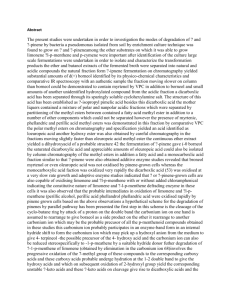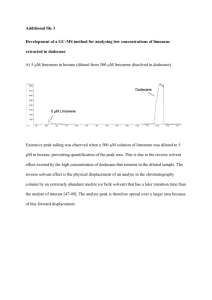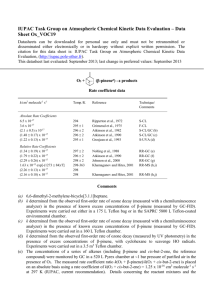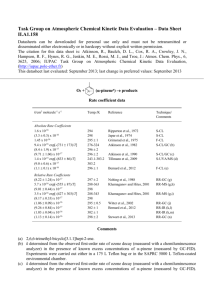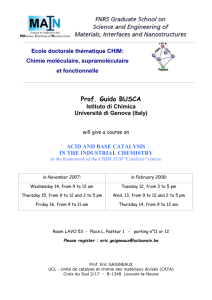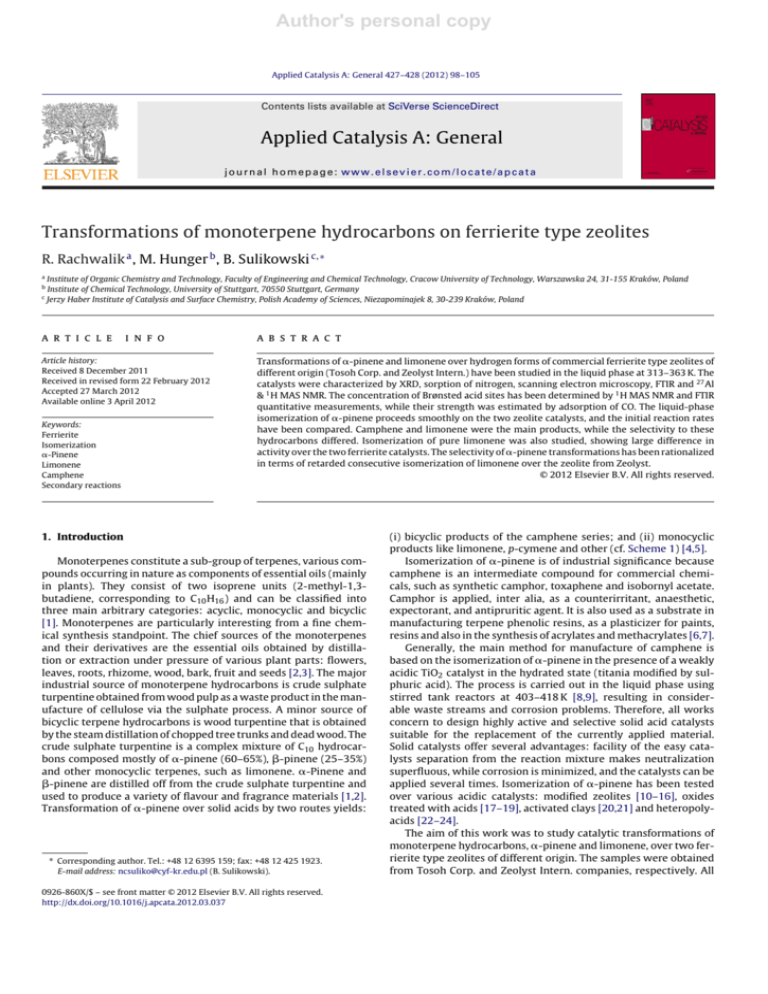
Author's personal copy
Applied Catalysis A: General 427–428 (2012) 98–105
Contents lists available at SciVerse ScienceDirect
Applied Catalysis A: General
journal homepage: www.elsevier.com/locate/apcata
Transformations of monoterpene hydrocarbons on ferrierite type zeolites
R. Rachwalik a , M. Hunger b , B. Sulikowski c,∗
a
Institute of Organic Chemistry and Technology, Faculty of Engineering and Chemical Technology, Cracow University of Technology, Warszawska 24, 31-155 Kraków, Poland
Institute of Chemical Technology, University of Stuttgart, 70550 Stuttgart, Germany
c
Jerzy Haber Institute of Catalysis and Surface Chemistry, Polish Academy of Sciences, Niezapominajek 8, 30-239 Kraków, Poland
b
a r t i c l e
i n f o
Article history:
Received 8 December 2011
Received in revised form 22 February 2012
Accepted 27 March 2012
Available online 3 April 2012
Keywords:
Ferrierite
Isomerization
␣-Pinene
Limonene
Camphene
Secondary reactions
a b s t r a c t
Transformations of ␣-pinene and limonene over hydrogen forms of commercial ferrierite type zeolites of
different origin (Tosoh Corp. and Zeolyst Intern.) have been studied in the liquid phase at 313–363 K. The
catalysts were characterized by XRD, sorption of nitrogen, scanning electron microscopy, FTIR and 27 Al
& 1 H MAS NMR. The concentration of Brønsted acid sites has been determined by 1 H MAS NMR and FTIR
quantitative measurements, while their strength was estimated by adsorption of CO. The liquid-phase
isomerization of ␣-pinene proceeds smoothly on the two zeolite catalysts, and the initial reaction rates
have been compared. Camphene and limonene were the main products, while the selectivity to these
hydrocarbons differed. Isomerization of pure limonene was also studied, showing large difference in
activity over the two ferrierite catalysts. The selectivity of ␣-pinene transformations has been rationalized
in terms of retarded consecutive isomerization of limonene over the zeolite from Zeolyst.
© 2012 Elsevier B.V. All rights reserved.
1. Introduction
Monoterpenes constitute a sub-group of terpenes, various compounds occurring in nature as components of essential oils (mainly
in plants). They consist of two isoprene units (2-methyl-1,3butadiene, corresponding to C10 H16 ) and can be classified into
three main arbitrary categories: acyclic, monocyclic and bicyclic
[1]. Monoterpenes are particularly interesting from a fine chemical synthesis standpoint. The chief sources of the monoterpenes
and their derivatives are the essential oils obtained by distillation or extraction under pressure of various plant parts: flowers,
leaves, roots, rhizome, wood, bark, fruit and seeds [2,3]. The major
industrial source of monoterpene hydrocarbons is crude sulphate
turpentine obtained from wood pulp as a waste product in the manufacture of cellulose via the sulphate process. A minor source of
bicyclic terpene hydrocarbons is wood turpentine that is obtained
by the steam distillation of chopped tree trunks and dead wood. The
crude sulphate turpentine is a complex mixture of C10 hydrocarbons composed mostly of ␣-pinene (60–65%), -pinene (25–35%)
and other monocyclic terpenes, such as limonene. ␣-Pinene and
-pinene are distilled off from the crude sulphate turpentine and
used to produce a variety of flavour and fragrance materials [1,2].
Transformation of ␣-pinene over solid acids by two routes yields:
∗ Corresponding author. Tel.: +48 12 6395 159; fax: +48 12 425 1923.
E-mail address: ncsuliko@cyf-kr.edu.pl (B. Sulikowski).
0926-860X/$ – see front matter © 2012 Elsevier B.V. All rights reserved.
http://dx.doi.org/10.1016/j.apcata.2012.03.037
(i) bicyclic products of the camphene series; and (ii) monocyclic
products like limonene, p-cymene and other (cf. Scheme 1) [4,5].
Isomerization of ␣-pinene is of industrial significance because
camphene is an intermediate compound for commercial chemicals, such as synthetic camphor, toxaphene and isobornyl acetate.
Camphor is applied, inter alia, as a counterirritant, anaesthetic,
expectorant, and antipruritic agent. It is also used as a substrate in
manufacturing terpene phenolic resins, as a plasticizer for paints,
resins and also in the synthesis of acrylates and methacrylates [6,7].
Generally, the main method for manufacture of camphene is
based on the isomerization of ␣-pinene in the presence of a weakly
acidic TiO2 catalyst in the hydrated state (titania modified by sulphuric acid). The process is carried out in the liquid phase using
stirred tank reactors at 403–418 K [8,9], resulting in considerable waste streams and corrosion problems. Therefore, all works
concern to design highly active and selective solid acid catalysts
suitable for the replacement of the currently applied material.
Solid catalysts offer several advantages: facility of the easy catalysts separation from the reaction mixture makes neutralization
superfluous, while corrosion is minimized, and the catalysts can be
applied several times. Isomerization of ␣-pinene has been tested
over various acidic catalysts: modified zeolites [10–16], oxides
treated with acids [17–19], activated clays [20,21] and heteropolyacids [22–24].
The aim of this work was to study catalytic transformations of
monoterpene hydrocarbons, ␣-pinene and limonene, over two ferrierite type zeolites of different origin. The samples were obtained
from Tosoh Corp. and Zeolyst Intern. companies, respectively. All
Author's personal copy
R. Rachwalik et al. / Applied Catalysis A: General 427–428 (2012) 98–105
99
Fig. 1. X-ray diffraction patterns of the hydrated hydrogen forms of ferrierite from Zeolyst and Tosoh.
the catalytic tests were carried out using a batch reactor working
at 313–363 K. The samples were characterized quantitatively by 1 H
MAS NMR and FTIR spectroscopies. In particular, FTIR spectroscopy
was used for estimating the strength of Brønsted acid sites.
2.3. SEM microscopy
The SEM pictures were taken with a Philips XL30 instrument.
2.4. MAS NMR spectroscopy
2. Experimental
The two commercial ferrierite type zeolites, K,Na-FER
(Si/Al = 8.9) and NH4 -FER (Si/Al = 10.0), were obtained from
Tosoh Corporation (Japan) and Zeolyst International (US), respectively. The ammonium form of the ferrierite from Tosoh was
obtained by an ion-exchange of a zeolite K,Na-FER with an 0.5 M
aqueous solution of ammonium nitrate. The ion-exchange process
was repeated four times at room temperature for 12 h each. The
ammonium-exchanged sample was washed with doubly distilled
water and dried at 373 K overnight. Finally, the ammonium forms
of ferrierite were calcined in air at 773 K for 5 h to yield the
hydrogen forms, labelled H-FER (T) or (Z).
The 27 Al MAS NMR spectra were acquired using a Bruker Avance
III 500 MHz spectrometer working at a magnetic field of 11.7 T,
with short 0.3 s single-pulse excitations (/10), a repetition time
of 0.5 s and 6144 accumulations. The fully hydrated samples were
spun at 14 kHz in 4-mm zirconia rotors. The 1 H MAS NMR spectra
were measured using a Bruker MSL400 spectrometer at a magnetic
field of 9.4 T, with single-pulse excitations of 2.2 s (/2), the repetition time of 30 s, 160 accumulations, and a sample spinning rate
of ca. 8 kHz. Prior to the 1 H MAS NMR studies, the samples were
dehydrated at 723 K for 12 h in a vacuum of p < 10−6 bar. The 1 H
MAS NMR intensities were evaluated taking into account the accumulation numbers and the sample weights. The concentration of
Brønsted protons was determined by comparing the signal integrals with that of a reference material.
2.2. Adsorption properties
2.5. FTIR spectroscopy
Adsorption of nitrogen was carried out using the Quantachrome
Autosorb Automated Gas Sorption System. Prior to the measurements, the samples were outgassed at 473 K for 24 h.
FTIR studies of CO adsorption at temperature of liquid nitrogen
were performed on self-supported discs of zeolites (ca. 10 mg/cm2 )
on a Bruker 48 PC spectrometer equipped with an MCT detector
2.1. Preparation of samples
Scheme 1.
Author's personal copy
100
R. Rachwalik et al. / Applied Catalysis A: General 427–428 (2012) 98–105
at a spectral resolution of 2 cm−1 . In most cases, 100–200 scans
were accumulated. The ferrierite samples were activated in situ in
the IR cell at 803 K for 2 h under a vacuum of p < 10−6 Pa. All FTIR
spectra shown in this work were normalized taking into account
the sample weights. The amount of Brønsted acid sites (i.e., the
bridging Si O(H) Al groups) was estimated by NH3 adsorption,
while their strength was calculated from shift of the O H bond
stretching vibrations upon adsorption of CO [30].
2.6. Catalytic tests
The ferrierite samples were tested in the isomerization of ␣pinene and limonene. Isomerization was carried out at atmospheric
pressure in a glass reactor equipped with a reflux condenser, an efficient stirrer (∼800 r.p.m.) and a temperature controller. In a typical
run, 5 ml of ␣-pinene or limonene (both from Aldrich) was heated to
desired reaction temperature. Before addition to the reaction mixture, the catalyst (0.25 g) was calcined at 673 K for 5 h in a helium
flow. The catalytic tests were carried out at the 313–363 K and
313–348 K temperature range for ␣-pinene and limonene transformations, respectively. After selected times, 10-L aliquots of
the reaction mixture were obtained for gas chromatography (GC)
analysis.
Conversion and selectivity were calculated as shown below:
conversion of ␣-pinene =
0
c␣-pinene
− c␣-pinene
· 100%
0
c␣-pinene
selectivity to camphene =
0
ccamphene − ccamphene
· 100%
0
c␣-pinene
− c␣-pinene
selectivity to limonene =
climonene
0
c␣-pinene
− c␣-pinene
· 100%,
where c␣-pinene , ccamphene , and climonene denote the concentration (mol%) of ␣-pinene, camphene and limonene in the reaction
products, respectively. The initial concentrations of ␣-pinene and
0
0
and ccamphene
. The concentrations
camphene are labelled c␣-pinene
of ␣-pinene and camphene in the feed were 98.63 and 1.13 mol%,
respectively. The conversion to limonene was calculated:
conversion of limonene =
0
climonene2
− climonene2
0
climonene2
· 100%,
0
and climonene2 are the concentrations (mol%) of
where climonene2
limonene in the feed and in the limonene isomerization products,
respectively.
3. Results and discussion
X-ray diffraction patterns of the two commercial samples
revealed characteristic diffraction lines consistent with the structure of ferrierite (FER) and good crystallinity. Ion exchange of
ferrierite from Tosoh with ammonium nitrate solution did not
affect the X-ray pattern. Similarly, calcination of the two ammonium forms to yield the corresponding hydrogen forms did not
result in any significant change in XRD (Fig. 1). Crystallinity of the
hydrogen forms, estimated on the basis of XRD patterns, was high
(>95%). The specific surface areas of the samples were very close
(287 and 275 m2 /g), and the H-FER (T) sample had slightly lower
Si/Al ratio (Table 1).
The SEM microphotographs of the two zeolites from Zeolyst
(Fig. 2a and c) and Tosoh (Fig. 2b and d) show nearly spherical
agglomerates uneven in size composed of smaller plate-like crystals. The agglomerates are larger and more uniform in size in the
case of the sample from Tosoh. The plate-like crystals are in the
range of 300–500 nm.
The main information, which can be obtained by 27 Al MAS
NMR spectroscopy, is the distribution of aluminium atoms between
framework and non-framework positions. In the 27 Al MAS NMR
spectra (Fig. 3a and b) the strong signals at 55 ppm are attributed
to tetrahedrally coordinated framework aluminium atoms. Additionally, in both spectra the second weak signals at 0 ppm could
be discerned, indicating the presence of octahedrally coordinated
extra-framework aluminium species. The intensities of these signals were equal to 15.6% for H-FER (Z) and 6.1% for H-FER (T),
respectively. Thus, ca. 2.5 times more octahedral aluminium was
present in the sample from Zeolyst (Fig. 3a).
1 H MAS NMR spectroscopy was used for quantitative and
qualitative assessment of different kinds of proton sites and
the concentration of Brønsted acid sites in the ferrierite samples, respectively. The proton spectra differ significantly, and the
main difference is, in addition to the bridging hydroxyl groups
Si O(H) Al at 4.2 ppm (i.e., the Brønsted acid sites [25]), the presence of relatively strong signals at 1.8 and 2.8 ppm in the spectrum
of H-FER (Z) (Fig. 4a). The isolated silanols groups at 1.8 ppm in this
sample are abundant, possibly due to smaller and/or more defected
ferrierite crystals from Zeolyst. In the spectrum of H-FER (T), the signal of Brønsted acid sites at 4.2 ppm essentially dominates, while
the signal of silanol groups at 1.8 ppm is weak (Fig. 4b). The strong
signal at 2.8 ppm in H-FER (Z) was assigned to the presence of
hydroxyl groups bounded to extraframework aluminium species
(AlOH) [26]. It is a direct evidence that a part of the aluminium
atoms exists as non-framework species, not inserted into the T
framework positions during hydrothermal synthesis and located
in the pore system and at the surface of crystals. The intensity
of this 1 H MAS NMR signal agrees very well with the 27 Al MAS
NMR signal at ca. 0 ppm, showing the ca. 16% of the aluminium
atoms are located outside the aluminosilicate framework (Fig. 3a
and Table 1). Finally, a weak 1 H MAS NMR signal at ca. 6 ppm is
assigned to hydroxyl protons interacting with the extraframework
aluminium species via hydrogen bonding [27]. The intensity of this
signal is higher in the spectrum of zeolite H-FER (Z), in accord with
what was considered above.
A signal of protons at 4.2 ppm was used in this work to calculate
the concentration of Brønsted acid sites in the ferrierite samples,
and the results are given in Table 1. As seen, the concentration of
Brønsted acid sites in the sample H-FER (T) is higher in comparison
to the other material. Moreover, the concentration of acid sites in
the second sample is much lower than the amount of tetrahedrally
coordinated aluminium atoms, connected via oxygens with these
hydroxyl protons. The negative framework charges must be, therefore, compensated, at least in part, by extraframework aluminium
species contributing also to the 1 H MAS NMR signal at 2.8 ppm.
Such a picture was also confirmed by IR spectroscopy (vide infra).
The IR spectrum of the H-FER (T) zeolite consists of three main
bands at 3748, 3600 and 3550 cm−1 (Fig. 5). These bands were
assigned to: (i) the external, terminal silanol groups Si OH and (ii)
the bridging Si O(H) Al groups located inside the 10-ring channels and inside the ferrierite cages, respectively. Additionally, a
small hump at 3650 cm−1 can be discerned in the spectrum due
to extraframework AlOH species [28].
The H-FER (Z) zeolite exhibits essentially a similar FTIR spectrum, however, some differences can be noticed. First, the main
band corresponding to Brønsted acid sites at 3600 cm−1 is broader.
Second, the hump at the 3650 cm−1 is more pronounced, in
line with the 27 Al and 1 H MAS NMR signals of extraframework
AlOH groups. And third, there are less external silanol groups
at 3748 cm−1 , while an additional hump at ca. 3730 cm−1 can
Author's personal copy
R. Rachwalik et al. / Applied Catalysis A: General 427–428 (2012) 98–105
101
Table 1
Characteristics of the two hydrogen forms of ferrierite.
Samples
H-FER (Z)
H-FER (T)
a
b
c
d
e
Si/Ala
10.0
8.9
SSAb [m2 /g]
287
275
Concentration of Brønsted acid sites [mmol/g]
Strength of acid sitesd
1
H MAS NMR
c
0.904
1.389
FTIR
av.
CO [cm−1 ]
PAe [kJ/mol]
0.840
1.172
0.872
1.281
295
286
1162
1168
d
Determined by chemical wet analysis.
SSA – specific surface area.
Determined by 1 H MAS NMR spectroscopy.
Determined by ammonia adsorption using FTIR spectroscopy.
The Proton Affinity calculated according to an equation in Ref. [30].
Fig. 2. SEM microphotographs of ferrierite samples: (a, c) H-FER (Z); (b, d) H-FER (T).
be discerned. The latter signal can be assigned to the internal
silanol groups located inside the zeolitic faults, thus confirming that
ferrierite from Zeolyst contains more faults. Finally, a broad shoulder at 3450–3550 cm−1 can be related to the hydrogen-bonded
Si O(H) Al groupings [29]. All these observations are in line with
the results of 27 Al and 1 H MAS NMR spectroscopy discussed above.
The strength of Brønsted acid sites was estimated by comparing the shift CO (cm−1 ) of the OH stretching vibrations
Fig. 3. 27 Al MAS NMR spectra of the hydrated samples: (a) H-FER (Z); (b) H-FER (T). The spectra were acquired using a Bruker 500 MHz spectrometer (11.7 T) with 0.3 s
single-pulse excitations (/10), the repetition time of 0.5 s and 6144 accumulations.
Author's personal copy
102
R. Rachwalik et al. / Applied Catalysis A: General 427–428 (2012) 98–105
Fig. 4. 1 H MAS NMR spectra of dehydrated samples: (a) H-FER (Z); (b) H-FER (T). The 1 H MAS NMR spectra were measured using a Bruker MSL400 spectrometer (9.4 T) with
2.2 s single-pulse excitations (/2), the repetition time of 30 s and 160 accumulations.
after adsorption of CO. The corresponding values are 295 cm−1
and 286 cm−1 for the Zeolyst and Tosoh samples (Table 1). The
adsorbate-induced band shift CO can be related to the proton affinity of the Brønsted acid sites. A relationship between
the observed band shift CO (cm−1 ) and the proton affinity (PA,
kJ/mol) can be calculated according to a formula given in Ref. [30]:
PA = 2254.8–442.5 log(). Hence, the calculated proton affinities
of the two H-FER samples are 1162 and 1168 kJ/mol (Table 1).
These data can be conveniently compared with that found for mordenite (1231 kJ/mol for hydroxyl protons located in side pockets,
and 1158 kJ/mol for those located in the main channels), zeolite beta (1156 kJ/mol) and non-acidic hydroxyl protons on SiO2
(1451 kJ/mol) [29,32]. It becomes clear that the Brønsted acid sites
of the two ferrierites are comparable to the acid sites located in the
main channels of mordenite and zeolite beta, but they are slightly
weaker in their acid strength. Finally, the overall concentration of
Brønsted acid sites in the H-FER (Z) sample is lower and the acid
sites exhibit a higher strength (Table 1). The higher strength of the
acid sites in H-FER (Z) can be rationalized taking into account two
points: a slightly higher Si/Al ratio in this sample and the presence
of more extraframework aluminium species (16%), as documented
by solid-state NMR and FTIR spectroscopy. The interaction of the
extraframework aluminium species with the Brønsted acid sites
increases their acid strength. Such a situation is frequently encountered in weakly dealuminated zeolites.
The transformation of ␣-pinene over the two hydrogen forms
of ferrierite of different origin was studied in the liquid phase.
The main products are camphene and limonene, accompanied by
smaller amounts of ␣- and ␥-terpinene, terpinolene and p-cymene.
The conversion levels over the catalysts are compared in Fig. 6. As
seen, at the beginning the ␣-pinene conversion over the ferrierite
catalysts increases rapidly and then levels out. It is also characteristic, and found for other zeolites [15,16], that the maximum
conversion levels are not corresponding to the highest temperature
studied (363 K). In our studies the highest conversion of ␣-pinene
was observed at 348 K for H-FER (Z) and 338–348 K for H-FER (T).
This point will be discussed further below.
The initial rate of ␣-pinene transformation was compared in
Table 2, taking into account the average amount of Brønsted acid
sites in the catalysts, as quantified by ammonia adsorption and 1 H
MAS NMR studies. We note that according to our earlier findings,
␣-pinene is adsorbed in the ferrierite channel system and interacts with the acid sites located there, as its molecular dimensions
(6.77 × 6.91 Å) are comparable with that of benzene [14,16]. The
initial reaction rate over H-FER (Z) at 313 and 338 K is considerably
lower, but increases sharply at higher temperatures approaching
8.8 mmol/mmol H+ min (Table 2). On the other hand, the initial
reaction rate over H-FER (T), higher at the beginning, equals to the
other catalyst at 348 K and then decreases. We note that the initial
reaction rates on the two ferrierite catalysts are generally higher
than those observed for other catalysts, exemplified by heteropolyacids supported on silica and sulphonated zirconium dioxide [14].
Table 2
Initial rates of ␣-pinene transformations over ferrierite catalysts, normalized to the
(average) amount of Brønsted acid sites.
Temperature (K)
Fig. 5. FTIR spectra of two dehydrated hydrogen forms of ferrierite: (a) H-FER (Z);
(b) H-FER (T).
313
338
348
363
Initial reaction rate of ␣-pinene [mmol/
1 mmol H+. min]
H-FER (Z)
H-FER (T)
1.97
1.83
4.99
8.78
2.87
4.96
4.97
3.29
Author's personal copy
R. Rachwalik et al. / Applied Catalysis A: General 427–428 (2012) 98–105
103
Fig. 6. Conversion of ␣-pinene at 313–363 K vs. the reaction time on: (a) H-FER (Z); (b) H-FER (T). The amount of a catalyst precalcined at 673 K: 0.25 g. Substrate: 5 ml of
␣-pinene.
The highest conversion was observed at lower reaction temperatures, i.e. 338–348 K (Fig. 6a and b). Further increasing the
reaction temperature leads to lower overall activity. Such behaviour
can be explained by considering the lower deactivation of zeolite
materials at 348 K. During transformations of terpene hydrocarbons, some by-products are formed. It is evident that at higher
temperature (363 K), in addition to isomerization products, formation of high-retention-time-products (HRTP) is more pronounced.
The precise nature of the HRTP products is not yet known. Among
them are oligomeric products containing multiple chemical bonds.
The HRTP products might consist of dimers, trimers and higher
oligomers. Specifically, dimers constitute the main part of reaction
products when -pinene is reacted over montmorillonite functionalized with sulphonic groups and perfluorinated sulphonic acid
resin (Nafion) [31]. Formation of oligomeric species is visible by
observing the catalyst colour, by GC and IR measurements (characteristic bands of C H and C C bonds). Oligomers constitute ‘coke’
precursors, similar to those appearing on zeolite catalysts working
in the gas phase reactions. They can block effectively the access of
substrate to the zeolite channels and acid sites located there. The
amount of HRTP at 348 K was 3.3 and 10.1% for ZSM-5 and ZSM12, and increased considerably to 6.7 and 14.9%, respectively, upon
increasing the reaction temperature to 363 K [16]. A pronounced
formation of HRTP over ferrierite manifests itself in decreasing the
conversion of ␣-pinene at 363 K.
Camphene and limonene are the main hydrocarbons formed
by ␣-pinene transformation. The highest total selectivity to these
products is ca. 90%. The selectivity to camphene increases with temperature and is essentially steady with the reaction time (Fig. 7). A
systematically higher selectivity to camphene is observed over the
H-FER (T) sample. The high selectivity to this monoterpene can be
attributed to its high stability. Once formed, it is not transformed
easily by consecutive reactions, especially if one takes into account
the lower strength of Brønsted acid sites in this catalyst.
The second valuable product formed by ␣-pinene isomerization
is limonene, and the selectivity to this hydrocarbon vs. time is visualized in Fig. 8. The selectivity at 363 K is constant with the reaction
time, equal to 45 and 35% on the two catalysts. At temperatures
of 338–348 K, the selectivity over H-FER (T) clearly drops down
with time (about 10%). The decrease of selectivity to limonene on
Fig. 7. Selectivity towards camphene as a function of the reaction time for the isomerization of ␣-pinene over H-ferrierite from Zeolyst (a) and Tosoh (b) at 313–363 K. The
conditions of catalytic tests were as in Fig. 6.
Author's personal copy
104
R. Rachwalik et al. / Applied Catalysis A: General 427–428 (2012) 98–105
Fig. 8. Selectivity towards limonene vs. the reaction time for the isomerization of ␣-pinene on (a) H-FER (Z) and (b) H-FER (T) at 313–363 K. The conditions of catalytic tests
were as in Fig. 6.
limonene
α−terpinene
γ−terpinene
terpinolene
p-cymene
Scheme 2.
Fig. 9. Conversion of limonene vs. the reaction time for the isomerization reaction on (a) H-FER (Z) and (b) H-FER (T) at 313–348 K. The amount of a catalyst precalcined at
673 K: 0.25 g. Substrate: 5 ml of limonene.
Author's personal copy
R. Rachwalik et al. / Applied Catalysis A: General 427–428 (2012) 98–105
the other sample at the same temperatures, although visible, is
much less pronounced. These observations confirm that limonene
is more reactive than camphene and, therefore, can be probably
further transformed, via a carbocation intermediate, into different
products of limonene group, such as terpinenes, terpinolenes and
p-cymene (cf. Scheme 2).
In order to verify experimentally this assumption, pure
limonene was used as a feed and the results of its transformation
over the ferrierite catalysts in the temperature range of 313–348 K
are depicted in Fig. 9. (At 363 K, the selectivity to limonene is nearly
steady during the reaction time studied.) As seen, the conversion
of limonene on the two ferrierite catalysts is strikingly different,
i.e. significantly higher over the zeolite from Tosoh (38%). At the
same temperature conversion over H-FER (Z) hardly exceeds 5%.
Limonene is, therefore, easily transformed into different products
on H-FER (T). On the other hand, the H-FER (Z) catalyst, exhibiting Brønsted acid sites of the higher strength and containing more
faults as well as more extraframework aluminium, tends to produce
more oligomeric species during the transformation of ␣-pinene.
The presence of such species inhibits efficiently formation of byproducts and directs the isomerization of ␣-pinene to the main
primary products, camphene and limonene.
Due to lower formation of oligomeric products, isomerization
of pure limonene proceeds more easily over zeolite H-FER (T) at
348 and 338 K. On this catalyst, limonene undergoes facile transformations to other hydrocarbons of the limonene group, like ␣- and
␥-terpinene, terpinolenes and p-cymene (Scheme 1 and Fig. 9). At
about 313 K, the isomerization of limonene is essentially stopped
(Fig. 9b). Therefore, in the transformation of pure ␣-pinene, the
selectivity to limonene vs. the reaction time remains practically
constant at this temperature, while it is decreasing by ca. 10% at
338 and 348 K (Fig. 8b).
4. Conclusions
We have shown that ␣-pinene can be transformed effectively
over the hydrogen forms of ferrierite of different origin. The initial reaction rates of ␣-pinene are high, and in general exceed
those found for other classes of catalysts, heteropolyacids and
sulphonated zirconium oxide. The characteristic behaviour of ␣pinene conversion vs. the reaction temperature can be related to
the formation of oligomeric products and the ability of a catalyst
to isomerize further the limonene formed. Formation of oligomeric
products is more pronounced on the ferrierite containing Brønsted
sites of higher acid strength. The H-FER (T) sample exhibits, at 363 K,
a higher selectivity towards camphene and a lower one to limonene
than the H-FER (Z) material does. Deposition of the HRTP products,
observed for both catalysts at 363 K, prevents efficiently consecutive reactions and, therefore, favours the formation of camphene
and limonene from ␣-pinene. Limonene can be further isomerized
over the ferrierite from Tosoh at 348 and 338 K giving terpinenes,
terpinolenes and finally p-cymene. These consecutive transformations of limonene, one of the two primary products formed over
ferrierite catalysts from ␣-pinene, are essentially not observed for
the H-FER (Z) ferrierite sample containing Brønsted sites of higher
105
acid strength. Different characteristics of the acid sites in the zeolite
materials under study with the same architecture is thus responsible for their particular catalytic behaviour in the transformations
of pure ␣-pinene and pure limonene.
Acknowledgements
We are grateful to Professor J. Datka and Dr. K. Góra-Marek of
the Jagiellonian University, Kraków, for the IR measurements. B.S.
is indebted to the Ministry of Science and Higher Education for the
NMR 500 MHz spectrometer equipment grant (project No. 75/E68/S/2008-2). The ferrierite samples were kindly supplied by Tosoh
Corporation (Japan) and Zeolyst International (US).
References
[1] C.S. Sell, The Chemistry of Fragrances From Perfumer to Consumer, 2nd ed., The
Royal Society of Chemistry, Cambridge, 2006.
[2] C.S. Sell, A Fragrant Introduction to Terpenoid Chemistry, The Royal Society of
Chemistry, Cambridge, 2003.
[3] E. Breitmaier, Terpenes, Wiley-VCH, Weinheim, 2006.
[4] V.P. Wystrach, L.H. Barnum, M. Garber, J. Am. Chem. Soc. 79 (1957) 5786–5790.
[5] A. Severino, A. Esculcas, J. Rocha, J. Vital, L.S. Lobo, Appl. Catal. A: Gen. 142
(1996) 255–278.
[6] R.G. Berger, Flavours and Fragrances, Chemistry, Bioprocessing and Sustainability, Springer-Verlag, Heidelberg, 2007.
[7] K. Bauer, D. Garbe, H. Surburg, Common Fragrance and Flavor Materials, 4th
ed., Wiley-VCh, Weinheim, 2001.
[8] M. Gscheidmeier, R. Gutmann, J. Wiesmüller, A. Riedel, US Patent 5,559,127
(1997).
[9] M. Gscheidmeier, H. Häberlein, H.H. Häberlein, J.T. Häberlein, M.C. Häberlein,
US Patent 5,826,202 (1998).
[10] C.M. Lopez, F.J. Machado, K. Rodriguez, B. Mendez, M. Hasegawa, S. Pekerar,
Appl. Catal. A: Gen. 173 (1998) 75–85.
[11] A.I. Allahverdiev, G. Gündüz, D.Y. Murzin, Ind. Eng. Chem. Res. 37 (1998)
2373–2377.
[12] A.I. Allahverdiev, S. Irandoust, D.Y. Murzin, J. Catal. 185 (1999) 352–362.
[13] C. Lopez, F. Machado, K. Rodríguez, D. Arias, B. Méndez, M. Hasegawa, Catal.
Lett. 62 (1999) 221–226.
[14] R. Rachwalik, Z. Olejniczak, J. Jiao, J. Huang, M. Hunger, B. Sulikowski, J. Catal.
252 (2007) 161–170.
[15] Ł. Mokrzycki, B. Sulikowski, Z. Olejniczak, Catal. Lett. 127 (2009) 296–303.
[16] B. Gil, Ł. Mokrzycki, B. Sulikowski, Z. Olejniczak, S. Walas, Catal. Today 52 (2010)
24–32.
[17] L. Grzona, N. Comelli, O. Masini, E. Ponzi, M. Ponzi, React. Kinet. Catal. Lett. 71
(2000) 27–32.
[18] M.A. Ecormier, A.F. Lee, K. Wilson, Micropor. Mesopor. Mater. 80 (2005)
301–310.
[19] N.A. Comelli, E.N. Ponzi, M.I. Ponzi, J. Am. Oil Chem. Soc. 82 (2005) 531–535.
[20] D.R. Brown, C.N. Rhodes, Catal. Lett. 45 (1997) 35–40.
[21] C. Breen, R. Watson, J. Madejova, P. Komadel, Z. Klapyta, Langmuir 13 (1997)
6473–6479.
[22] O. Masini, L. Grzona, N. Comelli, E. Ponzi, M. Ponzi, J. Chil. Chem. Soc. 48 (2003)
101–104.
[23] N.A. Comelli, L.M. Grzona, O. Masini, E.N. Ponzi, M.I. Ponzi, J. Chil. Chem. Soc.
49 (2004) 245–250.
[24] A.D. Newman, A.F. Lee, K. Wilson, N.A. Young, Catal. Lett. 102 (2005) 45–50.
[25] D. Freude, M. Hunger, H. Pfeifer, G. Scheler, J. Hoffmann, W. Schmitz, Chem.
Phys. Lett. 105 (1984) 427–430.
[26] Y. Jiang, J. Huang, W. Dai, M. Hunger, Solid State Nucl. Magn. Reson. 39 (2011)
116–141.
[27] C. Doremieux-Morin, P. Batamack, J.M. Bregeult, J. Fraissard, Catal. Lett. 9 (1991)
403–409.
[28] J. Datka, M. Kawałek, K. Góra-Marek, Appl. Catal. A: Gen. 243 (2003) 293–299.
[29] B. Gil, G. Košová, J. Čejka, Micropor. Mesopor. Mater. 129 (2010) 256–266.
[30] E.A. Paukstis, E.N. Yurchenko, Usp. Khim. 52 (1983) 426–454.
[31] B.G. Harvey, M.E. Wright, R.L. Quintana, Energy Fuels 24 (2010) 267–273.
˛
Micropor. Mesopor. Mater. 21 (1998) 75–79.
[32] J. Datka, B. Gil, J. Weglarski,


